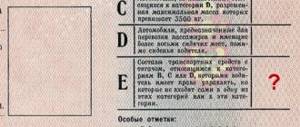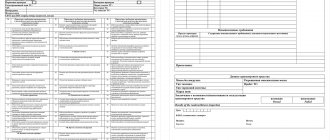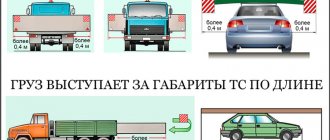Almost all cargo transported by various modes of transport can be divided into oversized and oversized. It is with the second that the greatest number of problems arise when organizing transportation. Therefore, it is necessary to find competent specialists and entrust the work to those who clearly understand all the features and nuances of such operations. Due to the weight, volume, shifted center of gravity and size of oversized cargo, special traffic rules requirements are being formed in 2018, which every carrier must follow. The characteristics of the cargo contribute to the complexity of its transportation. In order to avoid mistakes, you should understand the concept of oversized cargo, acceptable standards for transportation, as well as possible fines that will follow in case of violation of traffic rules.
How oversized cargo is transported.
Oversized cargo concept
The definition states that oversized cargo refers to unusually bulky and heavy items, the parameters of which exceed the established current standards. The concept is quite simple, but still has its own characteristics. To determine oversized cargo, sometimes it is enough to assess whether it can fit within a standard container or loading platform of a freight transport. Oversize is influenced by both the heaviness and the geometric characteristics of the object. According to the classification of oversized cargo, they differ in the following parameters:
- length exceeds 16 meters;
- height is more than 4 meters;
- the width of the cargo takes up over 2.55 meters.
These characteristics are specified in paragraph 23.5 of the traffic rules. If the cargo being transported meets these parameters, then its transportation will require a special permit. From here it is logical to find out what exactly applies to oversized cargo. The most common of them are:
- ships;
- water transport;
- construction equipment;
- road special equipment;
- Agreecultural machines. Agreecultural equipment;
- structures and products with non-standard dimensions (beams, large containers, metal structures, etc.);
- special machinery and equipment for industrial use.
As you can see, oversized cargo is a broad concept that includes many potential cargoes that require transportation. Transportation is carried out using low-loading platforms if the oversized cargo has a non-standard height. This makes it possible to significantly reduce the overall height of the cargo and the transport used to transport it.
Acceptable sizes
We have already determined which cargo is considered oversized and requires special permits for its transportation. But there are also categories of cargo that also fall under the characteristics of oversized cargo, but do not require special permits. When transporting them, it is necessary to strictly comply with the current rules provided for in the traffic rules.
This type of oversized cargo is provided for in 23.4 of the Traffic Regulations. This law says the following. Loads that protrude beyond the dimensions of the vehicle in front and behind by more than 1 meter, or on the side by more than 40 cm from the outer edges of the marker lamps, must be equipped with identification marks indicating large-sized cargo. If vehicles move in the dark and visibility is low, a white light or reflector must be placed in front. At the back, a similar device is installed, but with a red color.
Permissible limits are determined by:
- length;
- width;
- height.
Each characteristic has its own characteristics. It is necessary to study what is the permissible length of transported oversized cargo. That is, what is the maximum length of an object loaded onto a vehicle.
- Length. It is allowed to transport oversized cargo by vehicle if its length extends beyond the front or rear by a distance of 1 to 2 meters.
- Width. When transporting by road, the width of oversized items should not exceed 40 centimeters from the width of the vehicle itself. The load cannot extend beyond the specified distance. Otherwise, a substantial fine will follow, and the traffic police will recognize such transportation as illegal, that is, without special permission. Just keep in mind that measurements should be taken from the edges of the rear marker lights, and not just from the extreme point of the car.
- Height. The traffic rules do not stipulate restrictions regarding the height of the transported cargo. But here you need to take into account that it should be no more than 4 meters from the surface of the roadway.
Before sending, be sure to take measurements in all directions. If anywhere there is even a slight excess of the norm, you should definitely install a sign for large cargo. When transporting in the dark and in poor lighting, do not forget about additional lighting or reflectors. All these oversized dimensions are clearly regulated. Therefore, all those who carry out transportation must act strictly within the framework of the current rules. Otherwise, the legality of such transportation without permits or special signs will be in great doubt. Violation of traffic rules regarding oversized vehicles provides for a fairly severe punishment. It will be borne by both the driver himself and the entrepreneur involved in cargo transportation in violation of traffic rules.
If we are talking about oversized items that require special permission, a special scheme for organizing the route and delivering the object from one point to another is provided for it. All this is regulated by law, which is strictly not recommended to be violated. If certain circumstances arise that do not allow moving in accordance with the previously agreed route provided for in the issued permit, then the carrier is obliged to obtain a new permit along the changed route. Until it is received, vehicles with oversized items on board cannot travel on public roads.
Fine for oversized cargo
The amount of fines for violation of the requirements for the transportation of oversized cargo is established in Article 12.21.1. Code of Administrative Offenses and depend on the amount of excess of norms.
- for drivers from 1 to 10 thousand rubles or deprivation of rights for 2 - 6 months;
- for officials from 10 to 50 thousand rubles;
- for legal entities from 100 to 500 thousand rubles.
When choosing the size of the punishment, the court will be guided by the degree of exceeding the permissible dimensions.
For example, if the load protrudes beyond the norm by 20 - 50 cm, the amount of the fine for a legal entity will be in the range of 350 - 400 thousand rubles. The presence of aggravating circumstances will also be assessed: speeding, lack of reflective signs, improper location of the load.
If the excess is recorded by a photo frame, a fine under Art. 12.21.1. Code of Administrative Offenses will only come to the owner of the vehicle in the smallest amount - 150 thousand rubles. In accordance with paragraph 4 of the Constitutional Court Resolution of January 18, 2021 N 5-P. The resolution is valid until amendments to the Code of Administrative Offenses are adopted.
Two departments monitor compliance with the rules for the transportation of oversized cargo - Rostransnadzor and the State Traffic Safety Inspectorate.
During inspection, the inspector measures the vehicle in length, width and height with a telescopic ruler or tape measure. The tool must be certified. If the inspector detects a violation of acceptable standards, he draws up a report and a protocol on the administrative violation, and the vehicle can be sent to the impound lot. Responsibility for the violation will be borne by both the driver and the organizers of the transportation: officials and legal entities. In relation to the latter, Rostransnadzor is obliged to conduct an administrative investigation and, on its basis, issue a decision on non-compliance with the permissible dimensions of the vehicle.
If sanctions are imposed unfairly, they can and should be appealed.
Checking fines for legal entities. persons
Monitor fines, receive a daily report on new found fines and pay them automatically
Try for free
Oversized cargo sign
The use of the Large Load identification mark is due to the creation of an increased danger for other road users. To notify drivers of the approach of such vehicles, carriers of oversized cargo are required to be marked with a special sign, which is called Oversized Cargo. This is provided for in paragraph 23.4 of the traffic rules. This Oversize Load sign must be installed on more than just any part of the machine. It should be placed directly on the outermost part of the object, which protrudes beyond the dimensions of the car.
The choice of place where the Oversize or Large Load sign is installed directly depends on where the item being transported violates the dimensions of the transport. Therefore, if it protrudes from the back, then markings will be required there. If the cargo exceeds the dimensions at the back and sides, then a special sign must be placed on all these sides. You can often encounter situations where a carrier simply attaches some rags or ordinary red ribbons to an oversized vehicle, thereby notifying other road users of the potential danger. This is categorically incorrect and does not comply with traffic regulations.
Therefore, it would be logical to find out what size of the sign and its other characteristics are provided for by law if oversized cargo is transported. In general, the Oversized Load sign does not exist. It is simply actively used by carriers. Therefore, if we are talking about the need to deliver an item of non-standard dimensions, a standard sign for large-sized cargo is used. The following requirements apply to these elements:
- The sign for oversized or bulky cargo is presented in the form of a square;
- The dimensions are regulated according to GOST (R12.4.026-2001) and are 400 by 400 millimeters;
- To indicate oversized items, alternating stripes at an angle are used;
- The stripes are red and white;
- The width of each strip is 50 millimeters;
- It is allowed to use a picture or sticker that will meet the requirements of GOST;
- Make sure that each strip is made of reflective material, otherwise it will be a violation.
Taking into account this list of requirements, many people make and install such signs with their own hands. Making them is really not that difficult, since the markings are simple, and the symbols used are not difficult to implement without special skills and preparation. The main thing here is that a special material with a reflective effect is used. If your sign turns out to be smaller than the stipulated standards, then you will not be able to continue carrying oversized cargo after being stopped by a traffic police officer. Therefore, self-production among professional drivers is not encouraged. It is much easier to purchase a regulated sign and stick it on a rigid base. Next, it is mounted on those places where the load exceeds the dimensions of the vehicle.
Obtaining Permits
Not all motorists are faced with the need to transport oversized cargo, the transportation of which requires first obtaining a special permit. Therefore, most drivers are sure that such a document is issued by traffic police officers. But that's not true. The traffic police may take part in the transportation. Their task is to determine whether the truck requires escort by a traffic police official vehicle. But the permits themselves are issued by authorized bodies. It all depends on which roads will be used for transportation along the agreed route. They are:
- international;
- federal;
- municipal.
There is also now the concept of road owners. If the site is in someone’s private property, and there is a route for transporting large oversized items along it, then permission will need to be obtained from him. Basically, permissions are obtained from:
- Rosavtodor;
- Executive bodies of the subject of the country;
- Municipal authorities;
- Self-government bodies of a specific settlement;
- City district governments.
To begin the permitting procedure, you first need to submit an application along with a package of necessary documents. It includes a driver's license, car papers and a map of the route. If the authorized body requires it, it has the right to ask for additional information. Coordination and issuance of permits can take from 5 to 30 days. The procedure itself is considered conditionally free, that is, none of the authorized bodies has the right to charge any fee from the carrier. But there is a fixed amount of state duty, which is 1600 rubles. Additional costs may apply. Here everything depends on the need to prepare the route for transportation, or on eliminating damage caused by the large or oversized cargo being transported.
Permit for transportation of oversized cargo
As noted above, special permission must be obtained to transport bulky and heavy cargo. An application for issuing a permit is written to Rosavtodor of the region where the route begins. The application is accompanied by a package of documents indicated in paragraph 9 of Order No. 258:
- PTS or STS of a tractor and semi-trailer that will carry oversized cargo;
- diagram of the vehicle with the location of the load and the distribution of the load along the axles;
- information on technical requirements for the transportation of the declared cargo in transport position;
- a copy of the receipt for payment of the state duty.
The application and diagram must be certified by the applicant, and copies of documents for the vehicle must be certified by its owner or notary. Depending on the specifics of the situation, other additional documents may be required.
Registration of a permit takes place in several stages:
- Collection of documents from the list;
- Applying to the road department with an application in person, by mail or through State Services.
- Waiting for route approval.
The Director coordinates the drawn up route with the organizations that control the roads along which the route of oversized transport runs. After approval, the permit is signed by the traffic police. The entire procedure can take from one day to one month.
I can refuse to issue a permit in the following cases:
- it is possible to transport large cargo in another, safer way, for example by rail;
- the cargo can be disassembled into several parts;
- transportation does not provide absolute safety.
Formal reasons for refusal may include:
- errors in filling out the application;
- absence of at least one mandatory document;
- signature of the application by a person who does not have the authority to do so.
The state fee for obtaining a permit is 1,600 rubles.
If you need to obtain a permit as quickly as possible, you can contact a private intermediary organization. Such companies have experience in obtaining special permits, and therefore the process goes quickly and without errors. The cost of the service will depend on the nuances of the route and the size of large vehicles.
If Rosavtodor refuses to issue a permit, it is prohibited to transport oversized cargo without a permit. An administrative fine is provided for violation.
Penalties
If we talk about penalties for transporting oversized cargo, then there are two articles of the Code of Administrative Offenses of the Russian Federation:
- 21. Applies only to goods for which transportation does not require a special permit. This article primarily provides for a fine for improperly transported oversized cargo. If the driver violated the requirements for the length or width of an oversize vehicle, then the fine may be 500 rubles. There are officially no height restrictions, therefore a fine for oversized cargo exceeding any height marks cannot be issued. A warning is provided as an alternative penalty;
- 21.1. This article applies to improperly transported large cargo that requires special permits. Here the responsibility for transporting oversized cargo is more serious. The article includes 11 subsections, each of which regulates certain situations.
As you understand, if you transport oversized cargo without permission, or act not in accordance with traffic regulations, the violator faces a fine. Its minimum amount is 500 rubles. But this penalty is applied to ordinary violations, which imply:
- lack of a special identification mark for large cargo;
- increased noise level emitted by oversized cargo;
- insufficiently reliable fixation;
- obstructed view;
- raising a large amount of dust, disturbing traffic behind, etc.
Every driver is interested in the size of the fine that awaits him if he incorrectly transports oversized cargo. It all depends on the specific situation. If we talk about oversized cargo that does not require a permit, then only a warning or a fine is provided. The fine will be 500 rubles. But there is one caveat. Article 12.21 cannot deprive a driver of a driver's license. And here the inspector must turn to Article 23.3 of the Traffic Regulations. It stipulates that the driver does not have the right to continue driving until he eliminates the identified violations. And since the fact of the violation has been identified, and a fine for oversized cargo has been imposed, it will be impossible to continue the trip.
Before continuing your journey, you will need to properly secure oversized cargo, install special signs, or eliminate the source of noise. In the case of Article 12.21.1 of the Code of Administrative Offences, everything is much more complicated. Here we are talking only about situations with the transportation of oversized goods, for which it is mandatory to obtain transportation permits.
In total, the article is divided into 11 parts. Each of them explains what fine you will have to pay for oversized cargo.
- Here we consider the issue of moving oversized and large items exceeding the permissible dimensions of up to 10 cm, with or without permission. The driver is punished with a fine of 1 to 1.5 thousand rubles. The official responsible for the transportation is subject to a fine of 10-15 thousand rubles. For legal entities, the penalty will be 100-150 thousand rubles.
- If in a similar situation the dimensions are 10-20 cm larger than permitted, or the axle load is 10-20% larger than permitted, then fines in the range of 3-4, 25-30 and 250-300 are provided for the driver, responsible for transportation and legal entity thousand rubles respectively.
- If the dimensions exceed the norm by 20-50 cm, and the axle load is 20-50% and there is no special permit, drivers, officials and legal entities are punished with administrative fines in the amount of 5-10, 35-40 and 350-400 thousand rubles, respectively. . Or the driver may be deprived of his license for 2-4 months.
- If the dimensions are exceeded by 10-20 cm or the axle load by 10-20%, provided for in the permit, fines may be imposed in the amount of 3-3.5, 20-25 and 200-250 thousand rubles for drivers, officials and legal entities respectively.
- If the dimensions and axle load specified in the permit are exceeded by 20-50 cm and 20-50%, then this implies a fine of 4-5, 30-40 and 300-400 thousand rubles. respectively for the driver, official and legal entity. The driver may also be deprived of his right to drive a vehicle for a period of 2 to 3 months.
- If the dimensions exceed the permissible values by more than 50 cm, and the axle load is more than 50% with or without permission, then for each group of responsible persons penalties are provided in the form of fines of 7-10, 45-50 and 400-500 thousand rubles The driver may also be deprived of his license for 4-6 months.
- If rules are violated that do not include the previous 6 points, fines of 1-2.5, 5-10 and 50-100 thousand rubles apply for the driver, responsible for transportation and legal entity.
- If the shipper provides inaccurate information, or does not indicate in the documents the number, date or period of the current transportation permit, then the responsible persons will face punishment in the form of an administrative fine. A driver will receive 1-2 thousand rubles, an official from 15 to 20 thousand, and a legal entity from 200 to 300 thousand rubles.
- If the documents contain inaccurate information about dimensions and weight, or there is no information about the validity of the permit, which leads to violations of parts 3.5 and 6, then the fines for all responsible persons are 5, 25-35 and 350-400 thousand rubles, respectively.
- If an individual entrepreneur violates the permissible load on the vehicle axle, or exceeds the maximum weight of transported cargo provided for in the permit, then he will face a fine of 80-100 thousand rubles. For a legal entity, a similar offense is punishable by a fine of 250-400 thousand rubles.
- In case of violation of the requirements prescribed by established road signs to restrict the movement of heavy and large vehicles, the fine will be 5 thousand rubles.
It is important to note one nuance. If people engaged in business do not create a legal entity, they are still required to bear responsibility for offenses as legal entities.
If violations provided for in paragraphs 1 to 6 of the article in question are detected, in addition to a fine, vehicles are detained and placed in a special parking lot. There, the responsible persons can eliminate the identified violations. Only after this is their movement allowed to continue.
Exceeding the values specified in the permit
We have already found out what the fine is for transporting oversized cargo without permission, and now it’s time to find out what a motorist faces for violating the requirements specified in the waybill. These rules say the following about this:
- In case of non-compliance with GOST established by Rosavtodor, an ordinary citizen will face a financial penalty in the amount of 5,000 rubles;
- If you ignore the requirements for permission to transport oversized items, legal entities will have to pay from 80 to 100 thousand rubles.
Administrative penalties are also provided for providing false data on the volume and weight of luggage when contacting authorized bodies. But in such cases, the driver will face not only a financial penalty, but also the evacuation of his vehicle to an impound lot for up to 1 month.
When transportation is prohibited
According to current legislation, transporting this category of cargo is prohibited when creating an organized convoy. Transportation may also be prohibited if there is a real possibility of separate transportation that will not disrupt the operational properties of the items being transported. A ban on transportation is also issued in situations where there are no technical capabilities for such types of transport and transported items on the proposed route. You can clearly see that the issue of organizing the transportation of large and oversized cargo is extremely pressing. Literally all the subtleties are thought out here, which does not allow you to circumvent the law. Otherwise, drivers and other responsible persons will face serious punishment.











